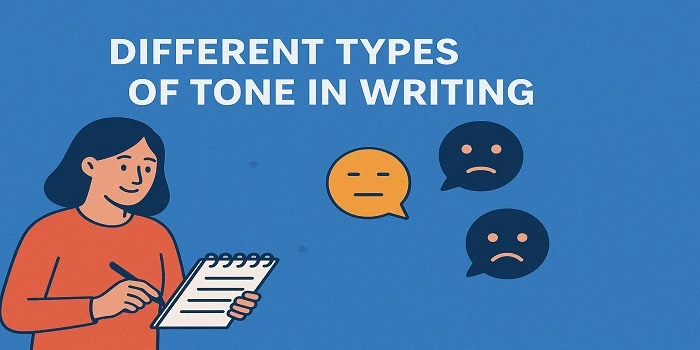Different Types of Tone in Writing
‘65% of students do not complete the assignment on time.’ – Neutral Tone
‘65% of students did not meet the assignment deadline, raising concerns about time management.’ – Critical Tone
Pause for a minute. Notice these two sentences. The first one has calmness and is fact-based, simple reporting. It is only here to share the result without any judgment. The other one, however, has an analytical twist to it.
It also points out a problem and suggests deeper issues behind the results. So, the lesson is that the same fact presented to the readers in different writing tones can be poles apart. Let’s now explore this art further to understand how tone shapes meanings and impacts in another way.
Elevate Your Writing with Different Types of Tones
In a situation where you are texting your friend and also emailing your professor. You would never say, ‘Yo, what’s up?’ to your professor, right? That is basically the tone in action. Though it is not just limited to informal communications. It applies to:
- Academic writing
- Professional emails
- Reports
- Presentations
- Research papers
In short, everywhere words matter, tone matters more. It also guides how your message is received, interpreted, and remembered. Moving on, here is why tone matters.
First Of All, It Avoids Confusion
The wrong writing style can sound rude, sarcastic, or too casual, even if you didn’t mean it. This is the reason why authors hire ebook ghostwriters. These experienced writer helps authors in making sure that the tone fits the audience and delivers the message with clarity.
Secondly, It Matches The Audience
To a teacher: ‘The statistics support the hypothesis.’
To a friend: ‘Looks like the numbers actually make sense!’
It Also Helps in Building Trust
A formal tone in academic writing shows you are serious and credible. In research papers, you will never use slang. It is all fact-based content with little or no space for what you think. Your thought, until backed by data, cannot be a part of the paper.
Lastly, It Sets The Mood
‘The results were surprising.’ → sounds neutral.
‘The results were shockingly unexpected.’ → sounds dramatic and emotional.
A Hierarchy Chart That Reveals the Different Tones

| Formality | ||
| Formal | Characteristics: Professional & serious Complex sentences No contractions or slang Third-person perspective | Uses: Academic papers Legal documents Official business reports. |
| Informal | Relaxed Conversational Friendly Uses contractions First-person perspective | Personal emails Casual blog posts Social media updates |
| Objectivity | ||
| Objective | Characteristics: Unbiased Fact-based & data-driven Avoids personal feelings | Uses: Scientific reports News articles Instructional manuals. |
| Subjective | Expresses opinions Individual bias is central to the message. | Opinion columns Personal essays Book/movie reviews. |
| Attitude | ||
| Persuasive | Characteristics: Confident & assertive Uses logical appeals and emotional language to convince the reader. | Uses: Marketing copy Advocacy letters Sales proposals Debates. |
| Humorous | Lighthearted Uses jokes and sarcasm Exaggerated to entertain | Comedy sketches Satirical articles Informal presentations |
| Empathetic | Supportive Aims to acknowledge and validate the reader’s feelings or struggles. | Customer service responses for complaints Mental health content Counseling materials. |
| Authoritative | Confident Knowledgeable Presents material as facts with solid statements. | White papers Expert testimony Educational textbooks. |
| Urgent | Creates a sense of immediacy Uses strong calls to action | Crisis communications Emergency alerts Limited-time sales promotions |
How to Choose the Right Type of Tone in 5 Steps
At times when you have an assignment, a dissertation, or an important letter to write, you naturally become stressed. However, if you are someone who doesn’t have the idea of what the right tone for the writing you are required to do, then there are two solutions.
The first is to find a reliable ghostwriting services UK and hire them to help you. Second is to follow the 5-step routine mentioned below. Both are equally beneficial for having a perfect final draft. Nevertheless, the choice is yours.
Step 1: Define Who You Are Addressing
Start by identifying your primary reader. For example, name the relationship you have with them. Are they your boss? Your client? Your friend? Or just the general public? Also, consider their level of expertise on the topic. This is important because a highly technical report for experts requires a formal and authoritative tone. But when you are writing an email to a colleague, it can be informal.
Step 2: Determine Why You Are Writing
Next, you need to clarify your goal for the communication. Once you know that you are trying to inform, you will use the right type, which is an objective tone. If you are intending to persuade, you will most likely be using an assertive tone.
On the contrary, if the purpose is entertainment, then a humorous tone is what will work best. All in all, the desired outcome is what commands the underlying attitude you must use.
Step 3: Analyze Where the Audience Will Read It
As soon as you are done with outlining your purpose, it is now time to evaluate the medium where the writing will appear. It is the same for a legal document, an academic essay, and an official proposal. All of them require a formal writing attitude. Conversely, social media, text messages, and a personal blog allow for a much more conversational style.
Step 4: Select What Mood You Want to Set
This step is all about choosing 2 to 3 specific adjectives, based on the first three steps. These words should be able to describe the attitude you want to project. For instance, it could be confidence, respect, seriousness, or enthusiasm. These words are going to act as fillers for your project while also setting the mood.
Step 5: Check How It Sounds
Last but not least, you need to review your draft for consistency. Start by looking at your word choices and sentence structures. Are you using strong action verbs for an assertive tone, or cautionary modal verbs (like may or might) for an objective tone? Make sure you do. Also, if a sentence sounds too casual or aggressive, it is better to revise it to match your target tone.
FAQ
- What is tone in writing, exactly?
Tone is the way your draft sounds to the reader. It shows your attitude or the intention behind writing, such as whether you are serious, friendly, excited, or just being formal. It also helps readers to understand how you feel about the topic and what kind of message you’re sending.
- Can tone change within the same piece of writing?
Yes, it can change depending on what you are talking about. For example, a report might start with a serious attitude and end with a hopeful one. However, the transformation must come across naturally.
- How do I make my attitude more persuasive?
To sound persuasive through your words, you need to be confident, clear, and respectful. You also must use strong yet polite words. Other than that, give good reasons while avoiding anger. A persuasive tone makes readers want to agree with your ideas.
- Can it affect how readers interpret my message?
Absolutely. It can change how people understand your words. A joke might sound rude if the tone is wrong, while a serious message might seem boring if the tone is too flat.
The Final Words
One sentence that sums up the entire situation is that it is not a one-size-fits-all approach. The tone in a writing must adapt to three things. The purpose, the audience, and the context.
Moreover, it is important to understand different types of tone, as it lets you gain the power to shape how your message is received and remembered. So remember this very crucial advice for life. No matter what you are writing, treat your tone not just as a writing tool, but as a way to connect meaningfully with every reader.

